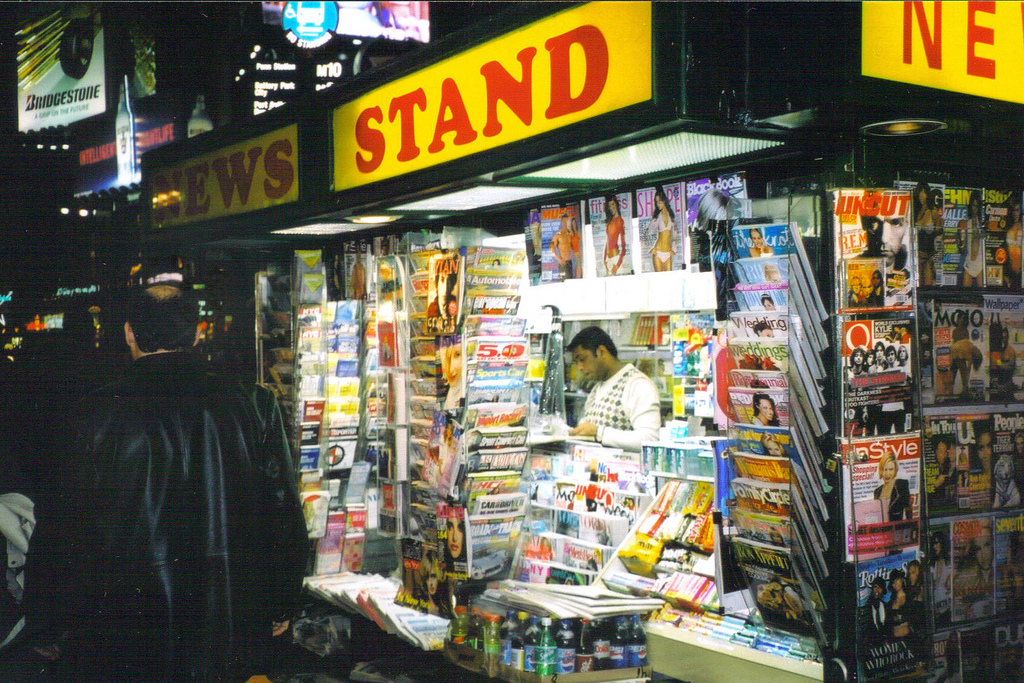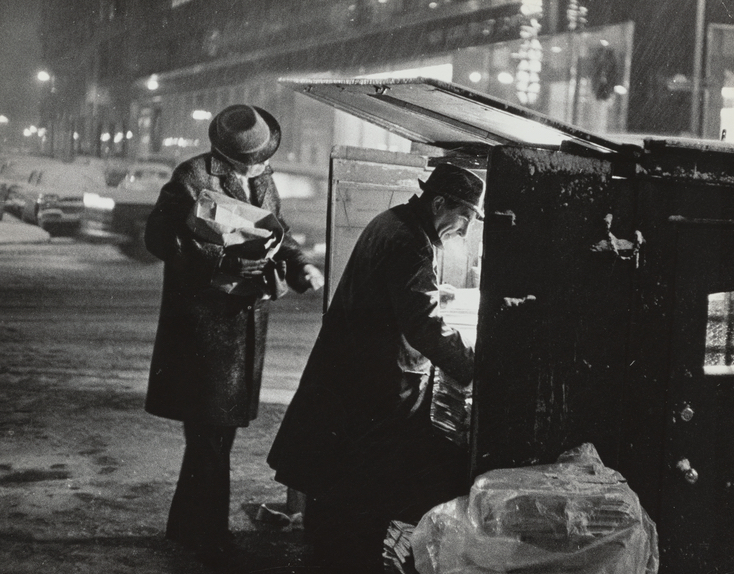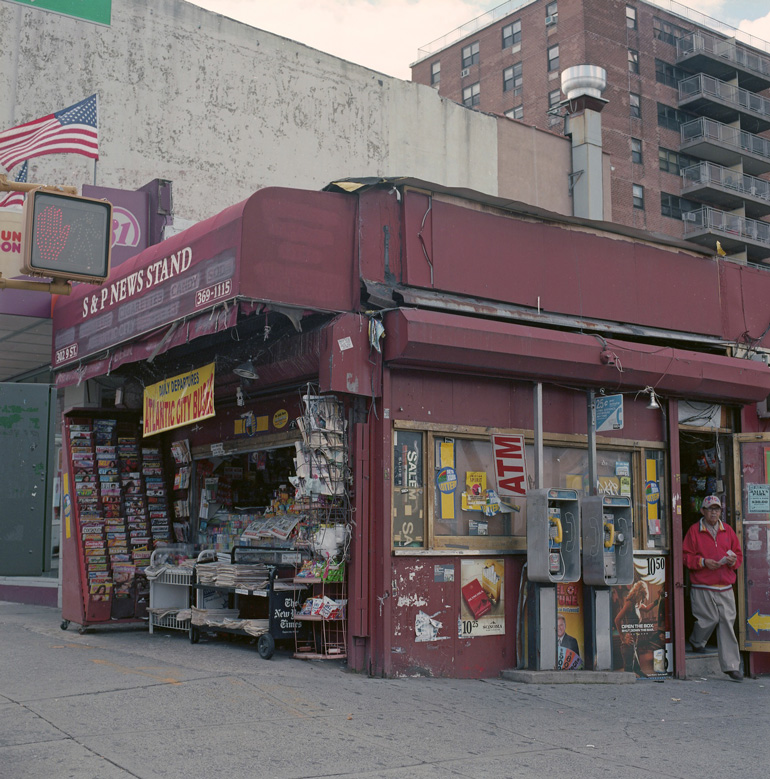Shelf Life
The city’s archivists, curators, and collectors pull out some of their favorite things, revealing multiple metropolises, imagined, expired, and ever-present.
We are celebrating 15 years — and counting — of stories that are deeply researched and deeply felt, that build a historical record of what the city has been.
Time was, when the news spread, it really motored. Whisked through the city streets on the back of a truck, slung to the curb, and brandished from a newsstand, the news was something that was first not there, and then arrived. Numbering above 1,500 in their 1950s heyday, newsstands have been unique neighborhood fixtures, as well as a key source of income for recent immigrants and veterans returning home from war. But 40 years later, when Mayor Rudolph Giuliani set out to clear the streets of disorderly elements, he included the city’s independent and architecturally eclectic newsstands. By 2005, at the city’s behest, Spanish company Cemusa had fashioned a fleet of standardized aluminum and frosted glass replacements; now only a fifth of the originals remain. Newsstand operators today, a majority of whom are still immigrants, may appreciate the improved security and efficiency of the city-sanctioned stands. But as the licensing fees charged by the city and the MTA eat into narrowing profit margins, and Cemusa collects the revenue from advertisements, it’s becoming harder to make a living from a newsstand. Those who do make their living selling candy, not the news. Even this, soon, may be taken over by vending machines.
This is because the news, notoriously, no longer sells. After slowing and stalling for decades, the local circulation of stories founders in the wake of recent events like the folding of the Village Voice and more than a hundred Daily News layoffs. As circulation migrates from the curbside to the Cloud, news nevertheless surrounds us. Subway riders, having swapped broadsheets for smartphones, gulp a constantly refreshing feed. But these disaggregated channels are, paradoxically, far from diverse: A constricted media mongers mostly the same stories, told in many of the same voices, to enclaves of like-minded readers. Though many of New York’s small ethnic papers and presses have managed to hang on, circulation has suffered and the papers themselves have receded from public view; some have cut back frequency or gone online, and others have shuttered entirely. As the news business falters, the former brokers of the city’s stories risk losing ownership not only of the source points, but of the stories themselves.
For Lizania Cruz, an artist and graphic designer hailing from the Dominican Republic, the danger of a single dislocated story comes through especially clearly in coverage of immigration. Faced with a media obsessed with border walls and caravans, and blind to immigrant experiences outside those narratives, Cruz began to wonder: What would it look like if people actually controlled their own stories? What it would look like in physical space? Her resulting project, We The News, collects a diverse and ever-growing set of stories at the intersection of race and migration. And to get them out and moving about in the world, Cruz has put a new spin on the old newsstand.
In transforming stories into a collection of physical objects, the history of do-it-yourself publishing and zine-making were clear inspirations. But the news is not merely a microphone: Editing, design, publishing, and distribution can be forms of solidarity and empowerment. Cruz reached for simple strategies common in editorial design — grids, typographical hierarchies — but eschewed templates. The design of each story incorporates its essence, sometimes foregrounding the person speaking, other times obfuscating their image to focus on the higher-order systems and processes that shape the immigrant experience. Each pamphlet, folded from brightly colored sheets and printed with a bilingual, edited transcript, asserts the individuality of the voice within. The documents became a family, and storytellers became collaborators and clients, working with Cruz to make the documents feel their own.
Cruz started in Bedford-Stuyvesant as part of The Laundromat Project‘s Create Change residency program. As well as her home of four years, Central Brooklyn has historically been a unique vantage from which the Black diaspora may regard itself. Since the 1970s, Afro-Caribbean immigrant communities have increasingly called Crown Heights, Bed-Stuy, and Flatbush home, while Bed-Stuy, Weeksville, Brownsville, and East New York have long histories as centers of Black American culture.
Cruz partnered with Albert Saint-Jean, chief organizer for the Black Alliance for Just Immigration (BAJI), a ten-year-old national advocacy organization that seeks to bridge those worlds and highlight the intersection of Blackness and immigration, and in July 2017, convened the first story circle at Hancock Community Backyard Garden Park in Bed-Stuy. Later, Cruz and BAJI would gather circles at museums, community centers, and homes in Flatbush, Harlem, the Bronx, and Washington Heights. Each time, a small group of Black immigrants and first-generation Black Americans shared food and stories, reflecting together on the complicated questions the conventional media seemed unwilling to ask. What did it mean to be both Black and an immigrant? Some had felt like outsiders even in their countries of origin, and in the countries passed through on the way to the US. Where was home, and how did they stay connected to it, even if they rarely — or never — returned?
For first-generation, long-term residents of the US, as well as for children of immigrants, identifications as Black people and as immigrants sometimes clashed in the eyes of a country that expected them to assimilate. Many reflected on the difference between race and culture.
Johane, who was born in Haiti but immigrated as a teen, told stories of having Blackness or Haitian identity “taken away” in public, even as her father enforced a French-and-Creole-only rule at home.
Christina said people from Haiti in NYC might characterize her as a “just come,” a recently-arrived immigrant to the US. She told of connecting to Haitian and Caribbean elders through her work as a tenant organizer.
Erin, Panamanian-American, described the importance of food for understanding her multifaceted identity, and shared a recipe for Jamaican rice and peas.
Recent immigrants and asylum seekers often told stories of trauma.
In long paragraphs, Abdul Mutalib described the winding trail from his home in Ghana, through South and Central America, to the US border — almost entirely by foot — and then into the immigration system.
Jean, an asylum seeker from Haiti, told of fleeing political persecution in his home country only to face racist violence in the Dominican Republic, Chile, Mexico, and finally the US. In publication, pieces of Jean’s story were redacted to protect his ongoing case.
Stories, of course, need readers. To that purpose, Cruz collaborated with architect Michael Yarinsky to design a newsstand for distribution. A simple plywood box on wheels, mobile and portable, opens up and folds out to set up shop at any likely crossroads. Stories on display dangle from metal clips, while others are free to take from the collection bin below. (Cruz also keeps the newsstand stocked with plantain chips, sorrel, and Ting, a popular Caribbean soft drink. Not just an emergency snack, food encourages conversation and creates connections.)
Cruz initially thought We The News would encourage those who are sympathetic to contemporary immigrants, but whose understanding of immigration comes from conventional media, to consider the overlooked experience of Black immigrants. But once a story’s out there, neither author nor publisher can control what happens. One early stop for the newsstand was the corner of Jefferson and Nostrand Avenues in Bed-Stuy, a nearly perfectly encapsulation of the communities that share the neighborhood. On the east side of Nostrand Avenue, Angela’s, a local favorite Caribbean restaurant serves up curried goat and Guyanese lo mein; to the west, Sista’s Place, a club and storied political organizing hub, pumps out jazz and hangs banners emblazoned with the faces of Malcolm X and Fredrick Douglass. Meanwhile, seemingly with each passing day, the steady stream of people trekking to and from the subway along Nostrand grows whiter. When We The News unfurled, passersby began to beeline toward the brightly colored pamphlets. Patrons from Sista’s Place crossed the street to survey the action and grab zines, asking challenging questions about the relationship of the newsstand to the gentrification of the neighborhood.
The next stop would be Washington Heights, home to a deep-rooted Dominican and Puerto Rican community. Cruz remembered well the animosity towards Black people that prevailed in the Dominican Republic, an experience echoed by story circle participants like Jean. Installation outside Word Up Community Bookshop revealed the extent to which the Dominican communities of Upper Manhattan resisted identification with the intersection of Blackness and immigration. But the physical presence of the newsstand made an opportunity to embark on — and redirect — those conversations in real time.
Recently, We The News has hit the road, setting up shop and convening circles at the August Wilson Cultural Center and City of Asylum in Pittsburgh, from October to March 2018, and at the ArtCenter South Florida and Ocean Drive, in Miami, last December. Partnering with local community organizations BAJI Miami and Family Action Network Movement (FANM) and African Services in Harlem, Cruz has gathered a new body of stories, 22 in all, to edit and prepare for publication.
Future installations will carry stories of Black immigration from Miami, Pittsburgh, Bed-Stuy, and Washington Heights to neighborhoods far and wide, continuing to collect stories along the way. Since fabrication on site was less expensive than shipping the original, three newsstands now exist; as the project proliferates it creates a network of shared experience, and shines light on an otherwise unseen terrain of Black migration. In the future, Cruz imagines sharing the architectural plans and story circle protocols with student groups and community organizations: We The News on every corner.
The views expressed here are those of the authors only and do not reflect the position of The Architectural League of New York.
The city’s archivists, curators, and collectors pull out some of their favorite things, revealing multiple metropolises, imagined, expired, and ever-present.



